By Cecille Jones, Monroe Master Gardener Volunteer
This article appeared in the July 2021 Issue of Gardening in Orange County.
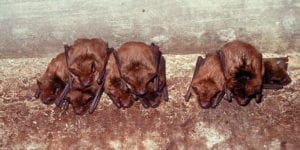
My informal poll on bats confirmed my suspicion: people either like them or hate them. There’s no in-between. I don’t mean to preach to the converted. But if you shudder at the thought of inviting these flying nocturnal mammals into your property, it’s time to talk facts about bats.
First, let’s bust some myths. People often use the phrase “blind as a bat,” but there are no bats that are actually blind. Additionally, bats are not flying rats. They belong to the order Chiroptera, not Rodentia. And not all bats have rabies, either. In fact, bats contract rabies much less frequently than other mammals. Moreover, bats do not suck people’s blood; nor do they get tangled in people’s hair.
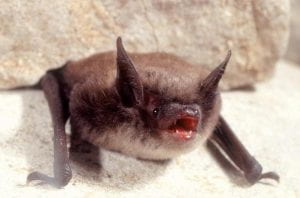
Ignore their bad reputation. It’s unwarranted. Instead, focus on creating an inviting space for bats to visit your yard so you can enjoy the many benefits these fuzzy creatures have to offer.
Like birds, bees and butterflies, bats are important pollinators – only they cover the night shift. According to the U.S. Forest Service, bats pollinate and disperse seeds for more than 700 plants. Without bats, you can forget avocados, bananas, dates, peaches, figs, mangoes and other commercially valuable crops. Bats are the only pollinator of the agave plant used to make tequila. Without them, you can kiss your margarita goodbye.
Bats are also excellent eradicators of pesky insects like mosquitoes, caterpillars, moths, gnats and flying beetles. They have been documented to eat bugs that attack pecans, almonds, corn, coffee, tomatoes, cucumbers and beans. A single bat can devour up to 1,200 mosquito-sized insects every hour. That makes bats your friendly provider of free nontoxic pesticide. Scientists estimate that bats in the United States save us billions of dollars in pest control services every year. That’s good reason to love, not loathe, bats.
Because bats feed on insects, they suffer when there are problems with insect populations or when habitats are destroyed or poorly managed. Hence, bats are good indicators of biodiversity.
To attract bats to your garden, plant flowers that are late-day blooming or night-scented. Here are some suggestions:
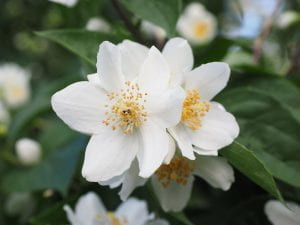 Mock orange shrub (Philadelphus virginalis): This late-blooming deciduous plant provides a stunning citrus fragrance and can be used in groups as screening or as a stand-alone specimen. They also make excellent cut flowers indoors. It’s not a true orange, and its name supposedly derives from the fragrant white flowers which in some varieties resemble that of orange blossoms.
Mock orange shrub (Philadelphus virginalis): This late-blooming deciduous plant provides a stunning citrus fragrance and can be used in groups as screening or as a stand-alone specimen. They also make excellent cut flowers indoors. It’s not a true orange, and its name supposedly derives from the fragrant white flowers which in some varieties resemble that of orange blossoms.
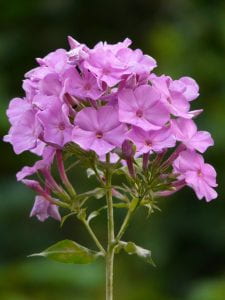 Phlox (Phlox paniculata): This native American wildflower is also known as garden phlox and summer phlox. They are sun-loving perennials with a long flowering season. Phlox are tall-eye-catching plants with large clusters of pink, lavender or white flowers, called panicles. They bloom for several weeks in summer and make excellent cut flowers.
Phlox (Phlox paniculata): This native American wildflower is also known as garden phlox and summer phlox. They are sun-loving perennials with a long flowering season. Phlox are tall-eye-catching plants with large clusters of pink, lavender or white flowers, called panicles. They bloom for several weeks in summer and make excellent cut flowers.
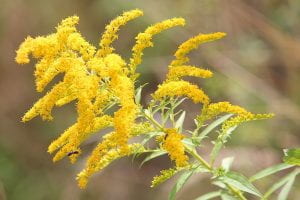 Goldenrods (Solidago spp.): A native to the United States, goldenrods have more than a hundred varieties, with one suitable for every climate. They are clump-forming perennial wildflowers that are topped with plumes of fluffy yellow flowers. Goldenrods provide nectar for pollinators and when planted near vegetables, can draw bad bugs away. They are thought to cause summer allergies, which is a misconception since the pollen from allergy-creating ragweed is present when the goldenrod blooms.
Goldenrods (Solidago spp.): A native to the United States, goldenrods have more than a hundred varieties, with one suitable for every climate. They are clump-forming perennial wildflowers that are topped with plumes of fluffy yellow flowers. Goldenrods provide nectar for pollinators and when planted near vegetables, can draw bad bugs away. They are thought to cause summer allergies, which is a misconception since the pollen from allergy-creating ragweed is present when the goldenrod blooms.
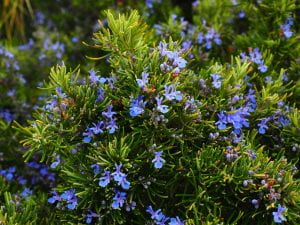
Herbs can attract bats as well. You can plant rosemary, thyme, chives, lemon balm and marjoram to attract bats to your garden. Just stay away from cinnamon, eucalyptus and peppermint. Bats are repelled by their scent.
Besides food, bats also need water and shelter. If you don’t live near a pond or stream, a birdbath will help attract them. And what could be more welcoming than giving bats a home of their own? You can buy a bat house online or make your own. The internet is brimming with DIY bat house plans, along with instructions on where to hang them.
Despite their bad reputation, bats actually do more good than bad. So give them a warm welcome and grow a bat friendly garden.
Bat Resources
Bat Conservation International
Bat Pollination – US Forest Service
Bats of New York – NYS DEC
White-Nose Syndrome Threatens New York’s Bats
Bats – NYS Integrated Pest Management
Bats – Oregon State Extension
Grow plants for bats! – University of Minnesota Extension
Wildlife Management: Bats – Cornell University
